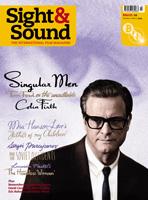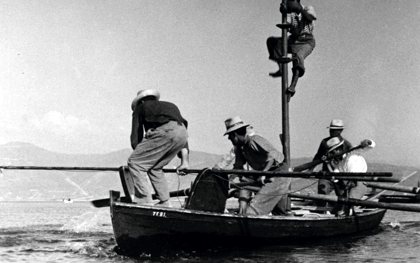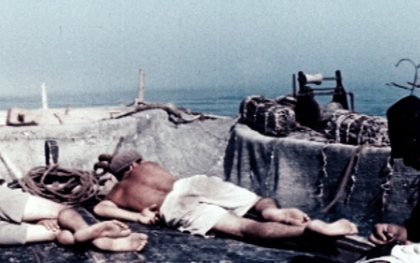Primary navigation


Vittorio De Seta’s stunning 1950s documentaries preserve everyday moments that we never even knew we’d lost, says Kent Jones
When Vittorio De Seta worked with the Cineteca di Bologna to restore his colour documentaries of the 1950s – recently released on DVD by Feltrinelli in cooperation with the Cineteca – he decided to think of them as one entity: Il mondo perduto, or ‘The Lost World’. Considering their uniformity of time, place and aesthetic approach, grouping these ten films together makes sense.
Six decades later, it seems striking that De Seta envisioned the disappearance of this pre-industrial world of shepherds and home-baked bread when it was still alive and well. Perhaps this is why these precious films existed for so long on the fringes of film culture: that extra, phantom dimension of loss in progress, indicated by the intensity of De Seta’s attention to dailiness, could only be divined 50 years after the fact, when the loss was fully complete.
De Seta was born into a wealthy southern Italian family in 1923 and studied architecture before turning to filmmaking. Unlike many of his generation, his relationship to cinema remained ground-level, artisanal, and strictly personal.
De Seta is credited with shooting most of these films himself, as he is on the first and most famous of his fiction films, Banditi a Orgosolo (1960). There were no industrial mandates to satisfy, no dictates beyond the artist’s own desire to chronicle not only the appearances of manual labour in Sardinia, Sicily and Calabria, but also the textures and rhythms of existence, the poetics of life as lived by fishermen and their wives, wheat harvesters or the inhabitants of mountain towns all but sealed off from modernity.

Lu tempu di li pisci spata (1954)
In the past 30 years our eyes have been opened to great swathes of the cinema’s past around the world. From Uchida Tomu through The Exiles, it is all cause for rejoicing. However, I don’t think I’ve discovered anything as surprising or enriching as these ten films, which are ‘documentaries’ in the tradition of Humphrey Jennings, as opposed to cinéma vérité. They are patiently observed and structured renderings of pre-industrial life in the manner of Robert Flaherty; they are also largely staged – there is not a single haphazard camera set-up in any of the ten films.
What is remarkable is how De Seta keeps refocusing our attention so that we get an event or series of interlinked events from multiple perspectives. In 1958’s Pescherecci, which places us on a boat with sardine fishermen in the straits between Sicily and Africa, the recording of tasks leads us to the ambient elements behind those tasks: work songs (a constant throughout most of the films); the humming motor; the approach of inclement weather. This leads on to the always impending danger of a storm at sea (images from the boat on wildly surging waves give new meaning to Emma Lazarus’ famous term “tempest-tossed”), which leads in turn to the passage of time from morning to night (another constant, along with juxtapositions of inside and outside), climaxing in the sudden appearance of a rainbow.
In Un giorno in Barbagia (1958) – which along with its companion film of that year, Pastori di Orgosolo, may be the most glorious of the shorts – De Seta painstakingly constructs what amounts to an omniscient point of view. He shifts between conservatively but colourfully attired women in small houses as they bathe children and bake bread (akin to another passage of ecstatic immersion in hand work in Pastori di Orgosolo, showing the making of goat’s cheese), wash clothes in the river, welcome kids home from school, prepare dinner for their exhausted husbands and put kids to bed, as day passes into night and the life of the entire small mountain town unfolds.

Pescherecci (1958)
What is remarkable is the sense of patience and care, the weight carried by each image within a compact structure. With the exception of I dimenticati (1959) – the last and longest at 19 minutes – the films are all roughly ten minutes in length, and the level of poetic compression is as high as in the best D.W. Griffith shorts. Within the rhythms of exalted dailiness proper to each film there are images that are heart-stopping: sheep passing across a snow-flecked mountainside in Pastori di Orgosolo, or the shepherd leaving the cold outside for the fire-lit warmth inside his hut; lava flows contrasted with the luxuriously dark images of waves crashing against rocks in Isole di fuoco (1954); the golden rain of wheat tossed with wooden pitchforks in Parabola d’oro (1955). De Seta edges in a painterly direction in a nicely unassuming manner: a wide shot of picnickers on a sloping, verdant hillside in I dimenticati feels as pungent and varied as a Brueghel, but it’s a natural link between two moments in European working-class life, hundreds of years apart, rather than an art-historical reference.
It should be acknowledged that De Seta has altered the films for their new DVD release. Where the aspect ratios of the shorts in their original versions varied, the filmmaker stipulated that everything be reformatted to 16x9. The colour has been carefully rebalanced, the soundtracks of each film meticulously rebuilt (in many ways, these are silent films with ‘found’ soundtracks), a voiceover has been removed and there have been small changes in the editing. The degree to which this is a restoration or a rethinking of the original work is debatable. What is not debatable is that these alterations resulted from aesthetic choices made by the filmmaker, and that they were all made in the spirit of his original, uncanny effort to record the final manifestations of this lost world.
Many thanks to my colleague Cecilia Cenciarelli for her help.
‘Il mondo perduto: I cortometraggi di Vittorio De Seta 1954-1959’ (‘The Lost World: The Short Films of Vittorio De Seta 1954-1959’) is available now on DVD from Feltrinelli.
Restoration heaven: Jonathan Rosenbaum reports from Bologna’s Il Cinema Ritrovato festival (July 2011)
Le quattro volte reviewed by Nick Bradshaw (June 2011)
You must be joking: Guido Bonsaver on Roberto Rossellini’s Francis, God’s Jester (May 2007)